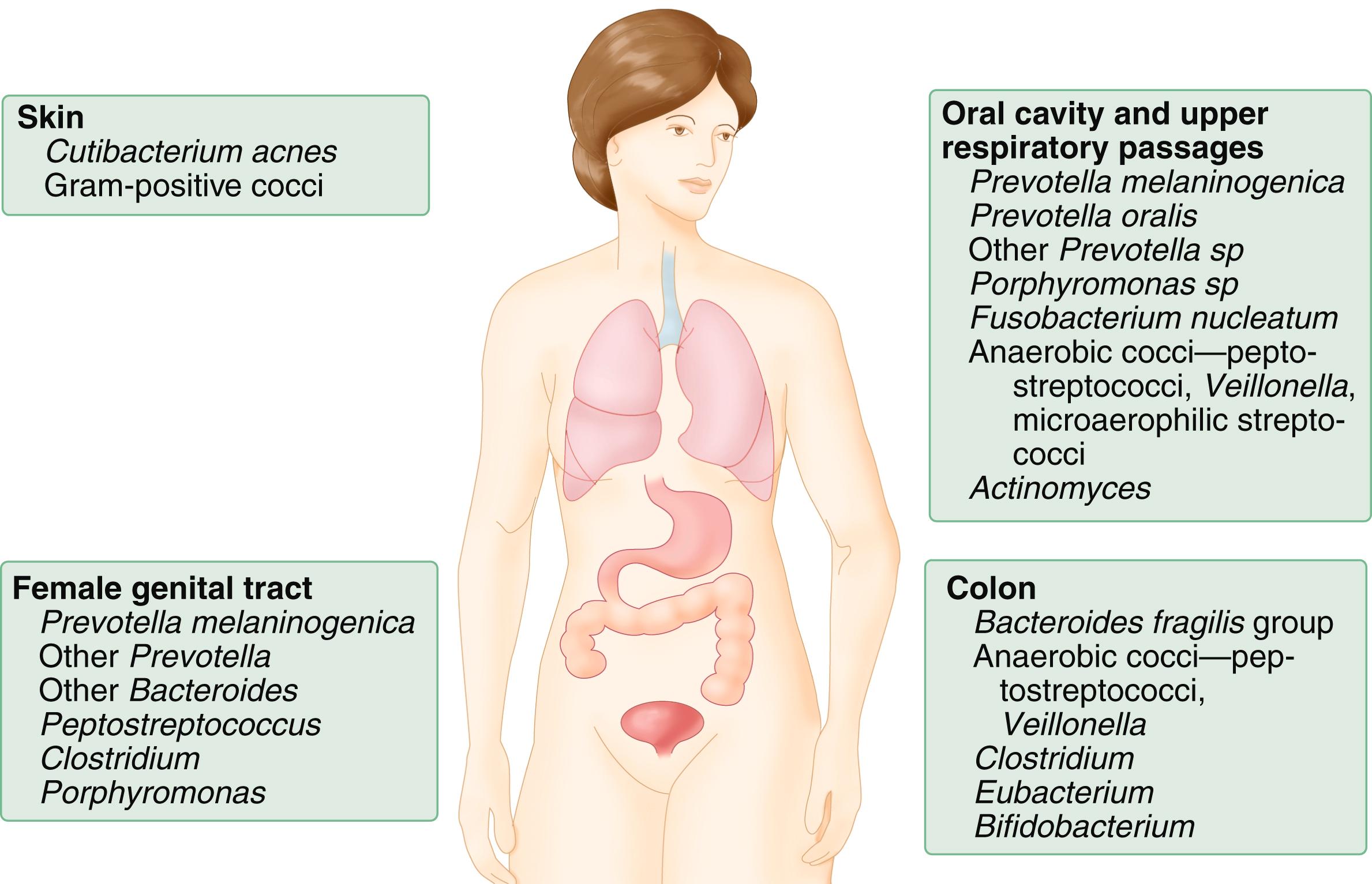Physical Address
304 North Cardinal St.
Dorchester Center, MA 02124
Anaerobic bacteria are the predominant members of the indigenous microbiota, including the skin and the oral, gastrointestinal, and vaginal mucosa ( Fig. 273-1 ; Table 273-1 ). However, the types of predominant anaerobes differ by location.

| NO. OF ORGANISMS PER GRAM | |||
|---|---|---|---|
| LOCATION | AEROBES | ANAEROBES | PREDOMINANT ANAEROBIC BACTERIA |
| Skin | — | — | Cutibacterium acnes Peptostreptococcus spp |
| Mouth/upper respiratory tract (in saliva) | 10 8 -10 9 | 10 9 -10 11 | Pigmented Prevotella and Porphyromonas spp Fusobacterium spp Peptostreptococcus spp Actinomyces spp |
| Gastrointestinal tract (in fecal material) | |||
| Upper | 10 2 -10 5 | 10 3 -10 7 | Bacteroides fragilis group Clostridioides spp |
| Lower | 10 5 -10 9 | 10 10 -10 12 | Peptostreptococcus spp Bifidobacterium spp Eubacterium spp |
| Female genital tract (in vaginal secretions) | 10 8 | 10 9 | Peptostreptococcus spp Prevotella bivia Prevotella disiens |
Advances in taxonomics have led to reclassification of many anaerobic species ( E-Table 273-1 ) over the past several decades. Fusobacterium nucleatum is the predominant Fusobacterium species isolated from clinical specimens.
| CURRENT NAME |
|---|
| Alistipes finegoldii |
| Alistipes onderdonkii |
| Alistipes putredinis |
| Alistipes shahii |
| Alloprevotella tannerae |
| Anaerobiospirillum thomasii |
| Bacteroides caccae |
| Bacteroides dorei |
| Bacteroides eggerthii |
| Bacteroides fragilis |
| Bacteroides massiliensis |
| Bacteroides nordii |
| Bacteroides ovatus |
| Bacteroides pyogenes |
| Bacteroides salyersiae |
| Bacteroides stercoris |
| Bacteroides thetaiotaomicron |
| Bacteroides uniformis |
| Bacteroides vulgates |
| Bilophila wadsworthia |
| Campylobacter gracilis |
| Campylobacter ureolyticus |
| Cutibacterium acnes |
| Fusobacterium canifelinum |
| Fusobacterium necrophorum |
| Fusobacterium ulcerans |
| Odoribacter splanchnicus |
| Parabacteroides distasonis |
| Parabacteroides goldsteinii |
| Parabacteroides gordonii |
| Parabacteroides johnsonii |
| Parabacteroides merdae |
| Porphyromonas asaccharolytica |
| Porphyromonas gingivalis |
| Porphyromonas macacae |
| Porphyromonas somerae |
| Porphyromonas uenonis |
| Prevotella bivia |
| Prevotella buccae |
| Prevotella dentalis |
| Prevotella disiens |
| Prevotella intermedia |
| Prevotella melaninogenica |
| Prevotella nanceiensis |
| Prevotella nigrescens |
| Prevotella oralis |
| Prevotella oris |
| Prevotella timonensis |
| Prevotella zoogleoformans |
| Sutterella wadsworthensis |
| Tannerella forsythia |
Anaerobes are opportunistic pathogens that can cause serious infections, generally synergistic infections in combination with aerobic bacteria. Because the microbiology of these infections is often complex and because culture results may be delayed, awareness of the normal bacterial microbiota at the site of infection is an indispensable guide for the selection and institution of empirical antimicrobial therapy.
Anaerobic bacteria range from those that cannot survive even a brief exposure to oxygen to those that can survive even in the presence of atmospheric oxygen (e.g., B. fragilis ). Most anaerobes require an environment with a low oxidation-reduction potential, which can be achieved in association with low pH, tissue destruction, byproducts from aerobic bacterial metabolism, or low oxygen content. Although they are not true anaerobes, some organisms, such as microaerophilic streptococci and other capnophilic or difficult-to-cultivate bacteria, are sometimes lumped together with anaerobes because of their fastidious nature. Some genera, such as Lactobacillus and Actinomyces , include both aerobic and anaerobic species. Anaerobic bacteria possess a variety of virulence factors that are species specific ( E-Table 273-2 ).
| FACTOR | SPECIES |
|---|---|
| ADHESION | |
| Capsule | Bacteroides fragilis group, Prevotella melaninogenica |
| Pili/fimbriae | B. fragilis group |
| Porphyromonas gingivalis | |
| Hemagglutinin | P. gingivalis |
| Lectin | Fusobacterium nucleatum |
| INVASION/TISSUE DAMAGE | |
| Proteases | Fusobacterium necrophorum |
| Bacteroides spp | |
| Porphyromonas spp | |
| Hemolysins | Many species |
| Endotoxin | B. fragilis |
| Fibrinolysin | B. fragilis group |
| Porphyromonas spp | |
| Heparinase | B. fragilis group |
| Porphyromonas spp | |
| Neuraminidase | B. fragilis group |
| Porphyromonas spp | |
| ANTIPHAGOCYTIC | |
| Capsule | B. fragilis group |
| P. gingivalis | |
| Lipopolysaccharide | B. fragilis group |
| F. necrophorum, P. gingivalis | |
| Metabolic products | Most anaerobes |
| TOXINS | |
| Endotoxin | B. fragilis |
| F. necrophorum | |
| Enterotoxin | B. fragilis |
Transient anaerobic bacteremia occurs in about 85% of patients immediately after dental cleaning or manipulation. An estimated 200 or more cases of endocarditis from anaerobes occur annually in the United States, usually in association with anatomic abnormalities or damaged cardiac valves ( Chapter 61 ). However, most anaerobic bacteremias are intermittent and associated with serious intra-abdominal or female genital tract, skin, and soft tissue infections, often proximal to the gastrointestinal tract. Which organisms are involved depends on their portal of entry and the underlying disease. The most common isolates are the B. fragilis group (60 to 75% of isolates). About 3 to 15% of bacteremias are caused by anaerobes, and they are the sole isolates in two thirds of these cases. The most commonly implicated anaerobes in bacteremia are Cutibacteria , B. fragilis , and Clostridioides spp. , Bacteremia with the B. fragilis group generally originates from a gastrointestinal source. Pigmented Prevotella , Porphyromonas , and Fusobacterium spp most commonly originate from oropharyngeal and pulmonary sources, Fusobacterium spp usually come from the female genital tract, and C. acnes usually from foreign body sources. Bacteremia with peptostreptococci is associated with all sources but especially with the oropharyngeal, pulmonary, and female genital tracts.
Become a Clinical Tree membership for Full access and enjoy Unlimited articles
If you are a member. Log in here